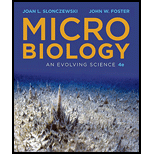
Concept explainers
To review:
The contradictions in defining
Introduction:
A microbe or a microorganism is defined as an organism that cannot be seen with the naked eyes and requires the use of a microscope. They exist in mountains, deserts, poles to equator, geysers, lakes, and the deep in the oceans. Some are suited to survive in the harsh conditions such as extreme hot or cold and under high pressure as well.
Explanation of Solution
Microorganisms are quite diverse and include bacteria,
There are also certain sulfur bacteria and plant algae that grow long leaflike extensions without undergoing cell division. There are some multicellular worms and arthropods that require a microscope to be seen but they are not considered microbes. Mushrooms and biofilms are complex organizations of cells that are differentiated into various types based on their functions. A virus has genetic material but is an acellular particle that takes over the
Want to see more full solutions like this?
Chapter 1 Solutions
Microbiology: An Evolving Science (Fourth Edition)
- Not part of a graded assignment, from a past midtermarrow_forwardNoggin mutation: The mouse, one of the phenotypic consequences of Noggin mutationis mispatterning of the spinal cord, in the posterior region of the mouse embryo, suchthat in the hindlimb region the more ventral fates are lost, and the dorsal Pax3 domain isexpanded. (this experiment is not in the lectures).a. Hypothesis for why: What would be your hypothesis for why the ventral fatesare lost and dorsal fates expanded? Include in your answer the words notochord,BMP, SHH and either (or both of) surface ectoderm or lateral plate mesodermarrow_forwardNot part of a graded assignment, from a past midtermarrow_forward
- Explain in a flowcharts organazing the words down below: genetics Chromosomes Inheritance DNA & Genes Mutations Proteinsarrow_forwardplease helparrow_forwardWhat does the heavy dark line along collecting duct tell us about water reabsorption in this individual at this time? What does the heavy dark line along collecting duct tell us about ADH secretion in this individual at this time?arrow_forward
 Biology Today and Tomorrow without Physiology (Mi...BiologyISBN:9781305117396Author:Cecie Starr, Christine Evers, Lisa StarrPublisher:Cengage Learning
Biology Today and Tomorrow without Physiology (Mi...BiologyISBN:9781305117396Author:Cecie Starr, Christine Evers, Lisa StarrPublisher:Cengage Learning Concepts of BiologyBiologyISBN:9781938168116Author:Samantha Fowler, Rebecca Roush, James WisePublisher:OpenStax College
Concepts of BiologyBiologyISBN:9781938168116Author:Samantha Fowler, Rebecca Roush, James WisePublisher:OpenStax College Human Heredity: Principles and Issues (MindTap Co...BiologyISBN:9781305251052Author:Michael CummingsPublisher:Cengage Learning
Human Heredity: Principles and Issues (MindTap Co...BiologyISBN:9781305251052Author:Michael CummingsPublisher:Cengage Learning





